St Clears is an ancient market town, situated alongside the main A40 road from Carmarthen into Pembrokeshire, about nine miles west of Carmarthen, and on the eastern bank of the River Tâf. The men of the town who fell during both World Wars are commemorated on war memorials inside St. Mary’s Church, and on the main War Memorial, which is situated opposite the Blue Boar in Pentre Road. The memorial was unveiled on 9 March 1921 by local hero Group Captain Ira ‘Taffy’ Jones, DSO, MC, MM and by Lieutenant-Colonel Delmé Davies Evans, DSO, 4th Welsh, to commemorate the fallen of St Clears, Llangynin and Bancyfelin. The nearby village of Llanddowror was invited to pay a share of the costs in order to commemorate their own men on the memorial, but they declined and erected their own. The St Clears memorial is an excellent testimonial to the men of the town who died in both wars, but as with so many others, there are a few men missing from it. These men are included below.
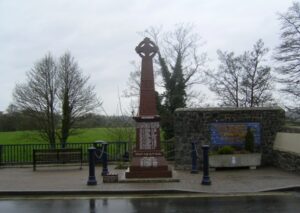
World War One, 1914-1918
Cyril Raymond Percival Cottrill, Private, TR7/9829, Training Reserve. Cyril was the son of Lieutenant Frederick Percy Cottrill and Bessie Evelyn Cottrill (née Lamb). The family had lived at Blaencorse Farm, St. Clears and at The Green, Llansteffan for several years, and Cyril was educated at Queen Elizabeth Grammar School prior to the family moving to Southsea. He enlisted at Sandown on 10 July 1916 after having worked in a munitions factory, and was posted to the 94th Training Reserve Battalion, which was based in Hampshire. On 15 April 1917 Cyril was admitted to Chiseldon Military Hospital, suffering from measles, but his medical notes state that he was ‘a pale undersize youth’, and Cyril quickly contracted pneumonia, and died on 7 May 1917, aged 17. He was buried with full military honours in Southampton Old Cemetery. His father was serving at sea with the Royal Navy. Cyril is not commemorated at St. Clears, but is on the Carmarthen Grammar School War Memorial.
Lewis Cunnick, Driver, 209756, Royal Field Artillery. Lewis was the son of James Cunnick and Anne Cunnick (née Scourfield), of Bancyfelin, St. Clears. He lived with his wife, Annie Cunnick (née Williams), at 28, Crown Street, Camberwell prior to the war, where he owned his own general store. Lewis enlisted at Wandsworth into the Royal Field Artillery, becoming a Driver in ‘C’ Battery, 37th Brigade, Royal Field Artillery, which was attached to the 75th Division. The Division was formed in Palestine in 1917, under command of the Indian Army. Lewis died in Palestine during the offensive in the Jordan, on 11 October 1918, aged 35, and is buried at Gaza War Cemetery, Israel.
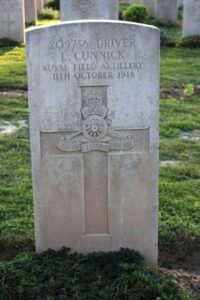
John Davies, Private, SE/2309, Royal Army Veterinary Corps. John was the son of Joseph and Eliza Davies, of Bush Inn, St Clears, and the brother of Thomas Evan Davies, of the Milford Arms, St. Clears. He had moved away from St. Clears ,many years before the war and enlisted at London into the Royal Army Veterinary Corps. John was posted to the 15th Veterinary Hospital, which was sent to serve in the Salonika Campaign. He was killed in action on 4 March 1917, aged 52, and is buried at Salonika (Lembet Road) Military Cemetery. John is not commemorated on the memorial. A nephew, William Rowlands, from Ambleston, was killed when his ship the SS Paddington was torpedoed and sank on 21 July 1917.
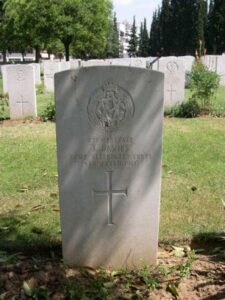
Joseph Thomas Davies, Seaman, M/5640, Royal Navy. Joseph was born on 1 September 1893, the son of Thomas Evan and Elizabeth Davies, of Milford Arms, St. Clears. Joseph was a carpenter when he enlisted into the Royal Navy on 21 January 1913 and was initially based at HMS Vivid I, the Royal Navy base at Devonport, for training. He spent a month at Plymouth Hospital between March and April 1914 and again later in the year. He returned to duty and served aboard HMS Jupiter and then HMS Erin until 25 March 1916 when he was posted back to HMS Vivid. He was hospitalised again and diagnosed as having contracted tuberculosis, so was sent to Newport Military Hospital, Monmouthshire, where he died on 1 September 1916, aged 23. Joseph is buried at St. Clears (St. Mary) Churchyard.

Thomas Davies, Corporal, 16317, Welsh Regiment. Thomas was born at Brynonen, near Bwlchnewydd Chapel, Laugharne in 1886, the son of John and Margaret Davies. The family moved to St. Clears when Thomas was young, and resided at Penpitch, with John working as a Platelayer with the GWR. The family later moved again, to 38, Henry Street, Bargoed. Thomas enlisted there soon after the outbreak of war into the 10th (Service) Battalion, Welsh Regiment. The Battalion had formed in 1914 and trained at Rhyl, then moved to Winchester, where it became part of 114 Brigade, 38th (Welsh) Division. Thomas landed with the battalion at Le Havre on 2 December 1915, and the Division moved to the Armentieres sector, where they were initiated into trench warfare. In June 1916 the Division marched south to the Somme, where on 7 July 1916 it launched its assault on the fortified Mametz Wood. The initial attack was repulsed at a heavy cost of lives due to well positioned German machine guns, and after a change in Commander renewed its assault on 10 July. The initial assault was renewed by 114 Brigade on the right, with two battalions of 113 Brigade on the left. Thomas was with the 10th Welsh in reserve, on the ground overlooking the wood. Later in the morning the 10th Welsh were sent into the wood to reinforce the Brigade. Thomas was wounded in the head at Mametz, and sent back to the UK via Hospital Ship. He died of his wounds at the 1st Welsh General Hospital, Liverpool on 23 July 1916. His body was brought back to Bargoed for burial, but he is commemorated on the Brookwood Memorial, Surrey, so his place of burial was not reported to the authorities. Following a lot of work, I have finally discovered that he is buried in Bedwellty (St. Sannan) Churchyard. I forwarded evidence to the CWGC in order for them to amend their records and this enabled Thomas to have a CWGC headstone, after 101 years without one! Thomas is not commemorated locally.
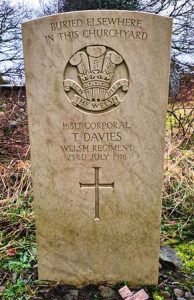
Thomas Howell Davies, Captain, South Wales Borderers. Thomas was born at St. Clears in the winter of 1886, the son of Thomas and Anne Davies, of the Holly Bush Inn, Station Road. His father was a Coal and Lime Merchant. By 1901, Thomas was living with his Grandfather at Waungron Farm, Whitland, and he was educated at Whitland Grammar School. Thomas became a Schoolmaster at Llanybydder prior to the war, and at the outbreak of war enlisted into the London Rifles. Thomas was by then living in London, and he married Edith Newman there in 1916, before being commissioned into the South Wales Borderers on 23 January 1916, and was posted to France with the 11th Battalion, South Wales Borderers, which formed part of 115 Brigade, 38th (Welsh) Division. Thomas fought with the Division throughout the war, at Mametz Wood in 1916, at Pilckem Ridge in 1917. Thomas was probably gassed whilst the 38th Division was at Armentieres early in 1918, before the 11th SWB were disbanded in February 1918, and was invalided back to Llain-y-Gors, Ystradgynlais, where Edith had set up home with their young son. Thomas succumbed to his gas wounds, and died on 6 October, 1919 aged 33. Thomas is buried at Ystradgynlais (St. Cynog) Churchyard. Thomas is not commemorated at St. Clears, but is named on the Whitland Grammar School Memorial.
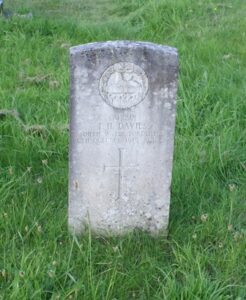
William Davies, Private, 15024, Welsh Regiment. William was born at St. Clears, and enlisted at Newport into the Monmouth Regiment. He later transferred into the 1/6th Battalion, Welsh Regiment, which had originally landed in France on 29 October 1914. The battalion joined 84 Brigade, 28th Division on 5 July 1915, and later became Pioneers to the 1st Division. The Division took part in the Battle of the Somme in 1916, and it was on the Somme, during the Battle of Flers-Courcelette that William was killed in action on 1 September 1916. He is buried at Flatiron Copse Cemetery, Mametz. William is not commemorated locally.
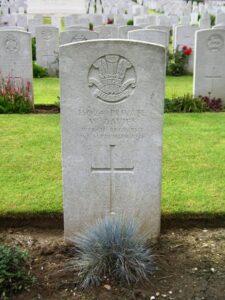
Frederick Elias, Lance Corporal, 201346, Welsh Regiment. Fred was the son of David and Mary Elias, of 2, Station Road, Carmarthen. Fred worked as a fisherman with his father prior to the war, before getting married to Sophie Narbett on 6 March 1915, and moving with his wife to Bridge Street, St. Clears, where the young couple had their only child, John. Fred enlisted into the 1/4th Battalion, Welsh Regiment, which was the local Territorial Battalion, attached to 159 Brigade, 53rd (Welsh) Division. The Division moved to the Mediterranean, sailing from Devonport in July 1915 and arrived at Mudros by 5 August 1915. From here they moved to Gallipoli, landing on 9 August. Here the Division was immediately thrown into action, and spent the next few days in isolated pockets, fighting against a Turkish counter-attack during the Battle of Sari Bair, and then at the Attack on Scimitar Hill. The Division remained here throughout the coming months, and suffered severe losses in manpower strength during the great November 1915 blizzard on Gallipoli, when its total strength was reduced to less than that of a full-strength Brigade. On 11 December 1915 the Division was evacuated to Mudros, and by 23 December 1915 were moved to Egypt. They remained on the Suez Canal Defences for the next twelve months, where it took part in operations against the Sultan of Darfur. Fred was wounded soon after returning to Egypt, and died of his wounds on 9 March 1916, aged 25. He is buried at Jerusalem War Cemetery, Israel. Fred is not commemorated on the St. Clears War Memorial.
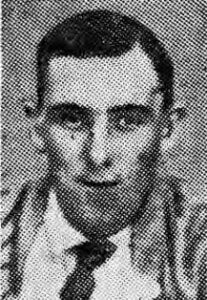
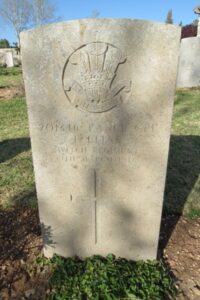
Aneurin Weber Evans, Private, M2/280558, Army Service Corps. Aneurin was born at Llanfihangel-Yr-Ystrad on 21 May 1885, the son of David Cledlyn Evans, M.Sc., and Margaret Evans, of Ardwyn, Brittania Terrace, St. Clears. Aneurin had trained as a schoolteacher at St. Clears County School, and at the South Wales Training College, Carmarthen, and had become Assistant Master at King’s Norton and King’s Heath, Birmingham. He enlisted at Birmingham into the Worcestershire Yeomanry on 4 February 1913, and had attended a training camp at Bulford prior to the outbreak of war. He married Doris Mabel Brighton, of Moreton, Bromsgrove, Worcs on 5 April 1916. On 20 September 1916 Aneurin landed in France, joining the 4th Battalion, Worcestershire Regiment. On 10 February 1917 he transferred to the Army Service Corps, where he served in the 717th Motor Transport Company. Aneurin’s Company was attached to IX Corps Heavy Artillery, and was stationed near Ypres at ‘E’ Siege Park, when he was killed in action on 30 September 1917, aged 32. He is buried alongside several other members of his Company at Locre Hospice Cemetery, which suggests that they were casualties of a shell burst.
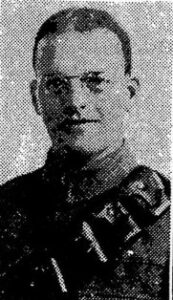
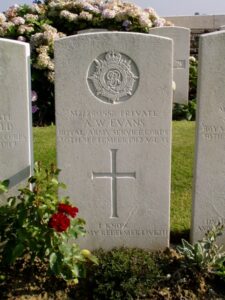
Richard William Ebsworth Evans, Private, 9804, Royal Fusiliers. Richard was the son of Tom and Mary Jane Evans, of 26, High Street, Merthyr Tydfil. His father was from St. Clears, and Richard and his siblings spent a lot of his childhood with his grandmother, Ann Thomas, at High Street, St. Clears. Richard enlisted at Merthyr in January 1916 into the Public Schools Battalion, Royal Fusiliers and on 10 July was posted to France, joining the 7th Battalion, Royal Fusiliers, which was attached to 190 Brigade, 63rd (Royal Naval) Division. Richard fought with the division during the Battle of the Ancre, on the Somme, later that year, before being sent on a two week Lewis Gun course. He rejoined the battalion in January 1917 and was killed in action a month later, on 8 February 1917. Richard was 21 years old and is buried in Queens Cemetery, Bucquoy, France. Richard is not commemorated at St. Clears.
Tom Luther Evans, Private, 10539, Welsh Regiment. Tom was born at St. Clears in 1893, the son of William and Martha Evans. By 1901 the family had moved to Coxlake, Narberth. At some time prior to 1911, Tom had enlisted at Llanelli into the 1st Battalion, Welsh Regiment. The battalion was stationed in India at the outbreak of war, and returned to Britain, where it joined 84 Brigade, 28th Division. The Division was made up of regular army units that had been brought back to the UK at the outbreak of war, and landed at Marseilles on 18 January 1915, moving to the Ypres sector. Tom was wounded at Ypres, and died of wounds on 4 February 1915, aged 21. He is commemorated on the Menin Gate Memorial, Belgium. His father William Evans also served and died after the armistice as a result of his service, but he is not commemorated anywhere. Tom is not commemorated at St. Clears, but at Narberth. His father William also fell during the war.
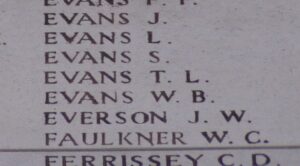
William Griffiths, Able Seaman, J.47924, Royal Navy. William was born in St. Clears on 8 January 1896, the son of Josuah and Sarah Griffiths, of Ffynonisaf, Backe. He enlisted into the Royal Navy on 30 December 1915, and trained at H.M.S. Vivid, before being posted aboard the W Class destroyer, H.M.S. Walrus, which was based at Greenwich. William survived the war, but became ill with influenza, and was hospitalised to Queensferry Hospital, Bangor, where he died on 19 March 1919, aged 23. His body was brought back to St. Clears, and he was buried at Pwll Trap Congregational Chapelyard.
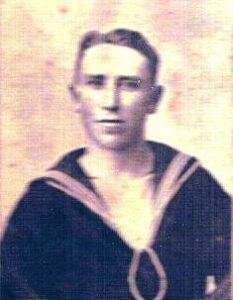
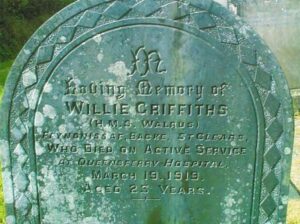
William Henry Guarneri, Private, 200064, Welsh Regiment. William was born at Haverfordwest in 1896, the son of John and Elizabeth Guarneri. The family later moved to Picton Ferry, St. Clears. William enlisted at Haverfordwest into the 1/4th Battalion, Welsh Regiment, which formed part of 159 Brigade, 53rd (Welsh) Division. On 9 August 1915 the Division landed at Gallipoli at Suvla Bay, and they fought there until mid December, when they were evacuated to Egypt. They fought in the Palestinian Campaign, where William was wounded during the First Battle of Gaza. William died of wounds on 29 March 1917, aged only 20 and is buried at Deir El Belah War Cemetery, Egypt. William is not commemorated at St. Clears or Haverfordwest.
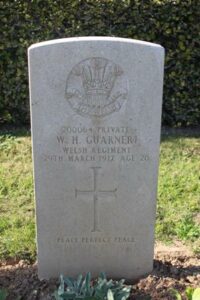
Robert Henry Harries, JP, Lieutenant, Royal Army Service Corps. Robert was born at Spittal on 11 December 1859, the son of Essex and Mary Ann Harries. The family later resided at The Croft, St. Clears. After moving to St. Clears Robert became Master of the Carmarthenshire foxhounds and a Justice of the Peace. He married Arabella Meager at Llanwnda Church, Goodwick on 21 September 1892 and the couple had two children. Despite his age he volunteered to serve in the army and was given a commission into the Army Service Corps. Robert served for two years at the Shirehampton Remount Depot, where he utilised his knowledge of horses to train fresh mounts for the army. His work there took its toll on his health and he returned to St. Clears where he died on 25 December 1918, aged 59. His body was conveyed to Manorowen and he was buried in Manorowen Churchyard, near Fishguard. Robert is not commemorated by the CWGC and is not named on the St. Clears memorial.
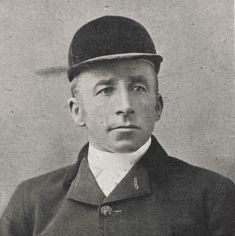
William Edward Gwyn Howells, Private, 227356, South Wales Borderers. William was the son of Thomas and Hannah Jane Howells, of High Street, St. Clears. He enlisted at Newport into the army, and was posted to France, joining the 2nd Battalion, South Wales Borderers, which was attached to 87 Brigade, 29th Division. The 2nd SWB were in China at the outbreak of war, and fought at Tsingtao before moving back to Britain, and took part in the landing on Gallipoli on 25 April 1915. The division remained at Gallipoli until evacuating on 11 January 1916, and from there were moved to France, arriving at Marseilles on 15 March that year. The division fought at the opening of the Battle of the Somme in July 1916, and the following year saw heavy fighting at Arras and at Ypres. The division took part in the desperate defence of Hazebrouck during the German Lys offensive of April-May 1918, and remained in the area throughout the summer. During August the division moved to the Merris sector, and began its part in the great offensive which would win the war. William was killed in action during the recapture of Outtersteene on 20 August 1918, aged 24. He is buried at Outtersteene Communal Cemetery Extension, Bailleul, France.
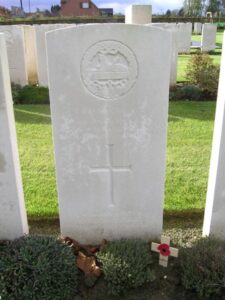
Thomas Husband, Lance Corporal, 54007, Welsh Regiment. Thomas was the son of John and Ann Husband, of Bryntaf, St. Clears. He worked for the GWR as a Porter prior to the war and enlisted at Bridgend into the Welsh Regiment. Thomas was posted to France, probably after the Pilckem Ridge offensive of July 1917, joining the 14th Battalion, Welsh Regiment, which was attached to 114 Brigade, 38th (Welsh) Division. The division had been in France since December 1915, and had taken part in the capture of Mametz Wood in July 1916 and Pilckem Ridge on 31 July 1917. The division then moved to the Armentieres area to rebuild. After the German offensive hit the Somme on 21 March 1918 the 38th Division was rushed south to bolster the British line north of Albert, facing the Ancre Valley. On 10 May 1918 the 15th Welsh, aided by two companies of the 14th Welsh, were tasked with the capture of the German positions within Aveluy Wood. The attack was a disaster, with an error in range calculations by the supporting Royal Artillery bringing down heavy shellfire on the Welshmen. Thomas was killed in action by a shell fragment during the attack, on 10 May 1918, aged 27. He is buried in Martinsart British Cemetery, France.
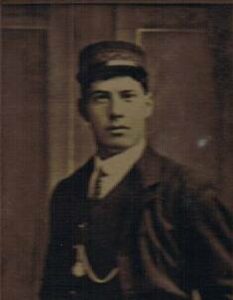
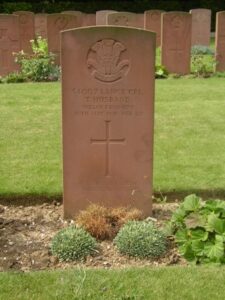
William James, Sapper, 763, Royal Engineers. William was the son of Evan and Phoebe James, of The Three Bells, St. Clears. William enlisted at Carmarthen into the 1/1st Welsh Field Company, Royal Engineers, which formed part of the 53rd (Welsh) Division. The Division moved to Gallipoli, landing at Suvla Bay on 9 August 1915. They were at Cape Helles during September when William was killed in action while the engineers were repairing trenches on 5 September 1915, aged 35. He is buried in Green Hill Cemetery, Gallipoli.
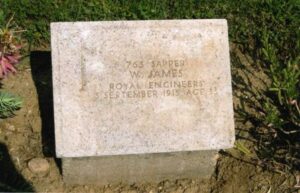
David Jones, Rifleman, 292, Rifle Brigade. David was the son of John and Frances Jones, of 18, Magazine Row, Carmarthen. He had worked as a Postman at St. Clears for several years prior to the war and enlisted at Carmarthen into the 1st Battalion, Rifle Brigade, which was attached to 11 Brigade, 4th Division. On 23 August 1914 the Division landed in France, and joined the main BEF, taking part in the Battle of the Aisne. The BEF then moved north, taking up positions around Ypres. David was killed in action whilst the Division were holding the line east of Ploegsteert Wood, south of Ypres, on 19 December 1914, aged 29. He is buried at Rifle House Cemetery inside Ploegsteert Wood, Belgium. A letter was found in his pocket which he had began writing to the Reverend Griffith Thomas, of Carmarthen, and was published in the Carmarthen Journal after his death.
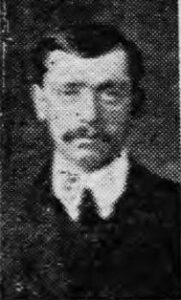
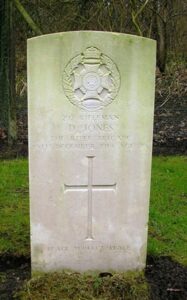
Samuel Gordon Jones, Lance Corporal, 17272, Welsh Regiment. Gordon was born in 1891, the son of Benjamin Spencer Jones and Annie Frederica Jones (née Thomas), of Brookfield, High Street, St. Clears. After Annie’s death in 1900 the family moved to Brynamman, but Gordon moved to Swansea. He enlisted at Swansea into the 14th Battalion, Welsh Regiment, known as the Swansea Pals. While on leave, he married Dorothy Gowman, of 126, Eaton Road, Brynhyfryd, Swansea. The 14th Welsh moved to France in December 1915 with 114 Brigade, 38th (Welsh) Division. During the winter and spring of 1916 the Battalion held nearly every section of the British line from Givenchy on the La Bassée Canal to Laventie, about six miles South of Armentières. At the end of May 1916, the Battalion moved South with the remainder of the 38th (Welsh) Division to the Somme area, in readiness for the First Battle of The Somme, which commenced on 1 July 1916. The 38th Division was tasked with the taking of the infamous Mametz Wood. The first attack on Mametz Wood was on 7 July, when the division lost heavily in ‘Death Valley’ during the advance on the ‘Hammer Head’. The next attack went in on 10 July, and after heavy fighting the wood was cleared, but at the cost of over 5,000 casualties in the 38th (Welsh) Division. Gordon was wounded during the first attack on 10 July, and was brought back to the Casualty Clearing Station at Daours, where he sadly Died of Wounds on 11 July 1916, aged 24. He is buried in Daours Communal Cemetery Extension, France. Gordon is not commemorated at St Clears.
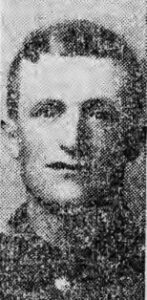
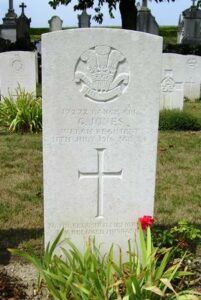
Theophilus Jones, Serjeant, PLY/2619, Royal Marine Light Infantry. Theophilus was born on 7 June 1863, the son of Walter and Elizabeth Jones, of Blaenmarlais, St. Clears. He enlisted into the Royal Marines on 7 August 1882 and while stationed in Devon married Elizabeth Jane Walker. The couple lived at the Royal Marine Barracks, Durnford Street, Stonehouse, Devon, where they raised their five children. Theophilus had dedicated most of his life to the Royal Marines and was still serving when he took ill and died on 5 March 1916 aged 52. He is buried in Ford Park Cemetery (Formerly Plymouth Old Cemetery). Theophilus had moved away from St. Clears while aged just 18 and must have been forgotten about as he is not commemorated on the towns’ war memorial.
Samuel King, Able Seaman, Wales Z/130, Royal Naval Volunteer Reserve. Samuel was born on 28 July 1893, the son of James and Mary Ann King (née Warren), of Swansea Road, Waunarlwydd, Swansea. His mother was from St. Clears, but had moved to Waunarlwydd with her parents by the age of ten. Samuel enlisted into the Royal Naval Volunteer Reserve and was posted to the 63rd (Royal Naval) Division, as a machine-gunner with the 189th Machine Gun Company. Soon after arriving in France he was court martialled for: ‘climbing cherry trees in orchard and bringing down cherries’ and was confined to barracks for five days and given extra fatigues! He was killed in action later that year, on 13 November 1916, during the Battle of the Ancre. Samuel has no known grave and is commemorated on the Thiepval Memorial, France. He is not commemorated at St. Clears.
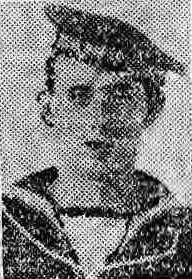
John Charles Lewis, Captain, Monmouthshire Regiment. John was born on 25 January 1886, son of John and Alice Lewis, of Troedybryn, St. Clears. He was educated at Whitland Grammar School, before enlisting into the Inns of Court Officer Training Corps, with the Army Number 8113. From here he was commissioned into the 1st Battalion, Monmouth Regiment. John was subsequently attached to the 6th Battalion, King’s Shropshire Light Infantry from 21 January1917 onwards, serving with the Battalion on the Somme during the Winter of 1916/17, then at Third Ypres (Passchendaele). The Battalion moved South on 1 October 1917, entraining at Proven for Bapaume. John was promoted Captain, taking over Command of ‘A’ Company, 6th KSLI. The battalion took over the front line trenches at Villers Plouich on 20 October, and took part in the attack on Welsh Ridge, during the Battle of Cambrai, on 20 November 1917. John was mortally wounded whilst gallantly leading his Company that day. He was in fact listed as killed in action that day, aged 30. He was reportedly buried between Gouzeaucourt and Combles, but his body was lost in the coming battles in the area, and he is commemorated on the Cambrai Memorial, Louverval, France.
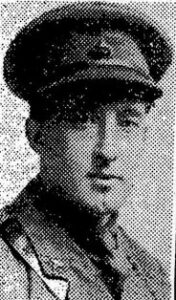

John Morgan, Private, 11354, Welsh Regiment. John was born the son of John and Mary Morgan, of Penpitch, St. Clears. He enlisted at Cardiff into the 8th Battalion, Welsh Regiment, which was the Pioneer Battalion to the 13th (Western) Division. The Division embarked for the Mediterranean on 15 June, 1915 and landed on ANZAC on 5 August. Just a couple of days after landing, the Battalion were thrown into their first full scale battle, the Battle of Sari Bair, and John was killed in action there on 8 August 1915 aged 40. He has no known grave, and is commemorated on the Helles Memorial, Gallipoli.
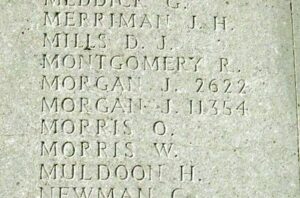
William Clifford Morgan, Pioneer, 237414, Royal Engineers. William was the son of William and Hannah Morgan, of Croft Cottages, St. Clears. Next door lived the family of William Edward Gwyn Howells, who was also killed during the war. By 1911 the family had moved to 13, Heath Crescent, Craigwen, Pontypridd, where William’s father had been working while Hannah raised the family at St. Clears. William enlisted at Pontypridd into the Royal Engineers and was posted to the 50th (Northumbrian) Signal Company, Royal Engineers. He served in France with the 50th Division but had returned home to Britain after his health had started to fail. William died in Edinburgh War Hospital on 30 December 1918, aged 20, and was buried with full military honours in Pontypridd (Glyntaff) Cemetery. William is not commemorated at St. Clears.
William Henry Owens, Corporal, 5655, 14th Hussars. William was the son of David and Martha Ann Owens, of 14, Capel Evan, Carmarthen. He had served in the army for several years prior to becoming a Postman at St. Clears in around 1913, and worked on the Llangynin round. At the outbreak of war he rejoined the colours, joining his old regiment, the 14th (Kings) Hussars. The 14th Hussars were based in India at the outbreak of War, so William was attached to D Squadron, Royal Horse Guards, which landed at Zeebrugge on 7 October 1914, attached to 7th Cavalry Brigade, 3rd Cavalry Division. The division took part in operations around Antwerp, before being moved to Ypres. Here they took part in the Battle of Langemarck, and the following Battle of Gheluveld. On 30 October 1914, the Royal Horse Guards were in the trenches about half a mile north-west of Zantvoorde, when they came under attack by superior numbers of Germans, forcing a retirement. William was shot in the back and killed during the ensuing fighting that day. He was 29 years old, and as his comrades could not recover his body, William is commemorated on the Menin Gate Memorial, Ypres. Different records record his surname as Owen and Owens: his birth was registered as Owens, and his military service and death as Owen, as can be seen below on the memorial.
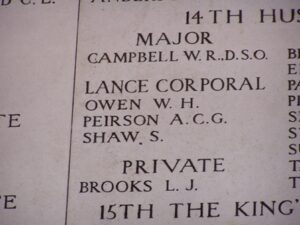
David George Perkins, Able Seaman, 197231, Royal Navy. David was born at Bushey, Hertfordshire on 31 August 1882, the son of George Perkins. George had retired from the Metropolitan Police, and bought the White Lion Hotel, Pwll Trap, and his five sons were educated there. George then sold up, and bought the Mason’s Arms, Clynderwen. Prior to the outbreak of war, David had already served for 14 years in the Royal Navy, and he sailed for the Mediterranean aboard the armoured cruiser, HMS Swiftsure, which was part of a large fleet, sent to support the Gallipoli offensive. David suffered from Gas Poisoning on Gallipoli, and Died of Wounds on 6 June 1915, aged 33. He was buried at Sea, and so is commemorated on the Chatham Naval Memorial, Kent. His brother, Ebenezer, also fell. Neither brother is commemorated at St. Clears.
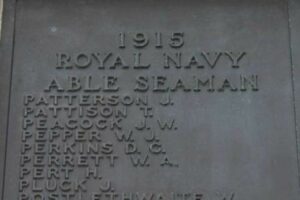
Ebenezer Perkins, Corporal, 11397, Somerset Light Infantry. Ebenezer was born at Chelsea, the son of George Perkins. George had retired from the Metropolitan Police, and bought the White Lion Hotel, Pwll Trap, and his five sons were educated there. George then sold up, and bought the Mason’s Arms, Clynderwen. Ebenezer resided at St. Clears prior to the War, and enlisted at Pentre into the 6th Battalion, Somerset Light Infantry, part of 43 Brigade, 14th (Light) Division. During May, 1915 the Division moved to the Western Front. They fought at Hooge and Bellewarde during late 1915 at Second Ypres, and gained the dubious honour of becoming the first Division to be attacked by flamethrowers at Hooge. They moved to the Somme at fought at Delville Wood before moving North to Flers, where it was during the Battle of Flers-Courcelette that Ebenezer was Killed in Action on 16 September, 1916 aged 27. He is commemorated on the Thiepval Memorial. His brother, David George Perkins, was killed at Gallipoli. Neither brother is commemorated at St. Clears.
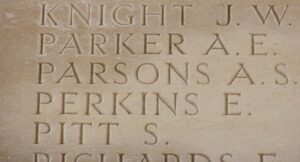
Jason Peters, Able Seaman, Z/2331, Royal Naval Volunteer Reserve. Jason was born at Clynderwen on 9 September 1892, the son of Thomas and Margaret Peters of Jones Terrace. The family moved upon the death of Jason’s father to Bethesda Cross, near Narberth, while Jason moved to St. Clears to work as a groom for R. H. Harries, of the Croft. Jason enlisted at Abertridwr into the Anson Battalion of the Royal Naval Division, part of 189 Brigade, 63rd (Royal Naval) Division. The Royal Naval Division had been formed at the request of the First Lord of the Admiralty, Winston Churchill, making use of the several thousand men of the Royal Naval Volunteer Reserve who were left without ships to serve on, and were surplus to requirements. They first saw action during the Defence of Antwerp, and were sent to Gallipoli. They saw substantial service here, and by the withdrawal from the Peninsula, very few of the original men with naval service remained. The Division arrived at Marseilles during May 1916, and were used in the Somme offensive, taking part in the Battle of the Ancre, where they made a distinguished name for themselves that was to live with them throughout the war. It was during this Battle that Jason was killed in Action on 13 November 1916. He was 24 years old, and his body was lost in the now swamp-like Ancre Valley. He is remembered on the Thiepval Memorial, France. Jason is not commemorated at St. Clears, but at Clynderwen.
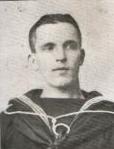
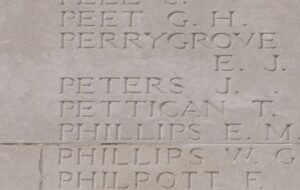
John Lewis Phillips, Private, 25631, Lancashire Fusiliers. John was born at the Post Office, Llanddowror on 15 May 1897, the son of William and Eliza Phillips. He received his education at the Church School, and on his nineteenth birthday, 15 May 1916, he joined the Royal Field Artillery as s Driver, Regimental Number 137568. In July 1916 he was transferred to the Lancashire Fusiliers and went out as Private to France to join the 11th Battalion, regimental Number 25631, and He served with them in the 25th Division from 20 December 1916. John took part in the engagements at Arras in March 1917, at Messines in April 1917, at the 3rd Battle of Ypres, at Cambrai and St. Quentin in March 1918. His battalion was caught up in heavy fighting during the German Offensive when John’s Lewis Gun jammed. He was repairing it when he was hit in the temple by a bullet, and killed on 23 March 1918, aged 20. His body was lost on the battlefield, and so he is commemorated on the Arras Memorial, France.
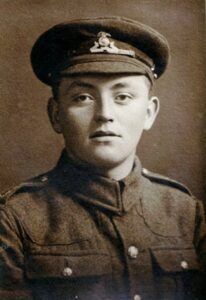
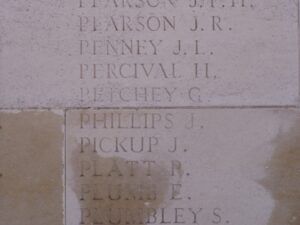
Edward Rees, Private, 2201, Australian Imperial Force. Edward was born at Meidrim, the son of Thomas and Theodosia Rees, of Mount Pleasant. He emigrated to Australia prior to the outbreak of war, and enlisted at Victoria on 4 March 1915 into the 14th Battalion, Australian Imperial Force (known as ‘Jackas Mob’ after one of its fearless officers, Albert Jacka, VC). He joined the Battalion on Gallipoli on 1 August 1915 and fought at Lone Pine, and remained at Gallipoli until the evacuation. His service papers show that he was at Heliopolis by February 1916, court martialled for drunkenness, and was taken on strength by another Battalion, the 46th on 3 March 1916. After spells in Hospital at Ismailia, Edward embarked at Alexandria on 6 August 1916 bound for Marseilles. He rejoined his Battalion in the field on 23 September 1916, by which time they had taken part in the Battles of Pozieres and Mouquet Farm, and had been withdrawn from the line and sent to Ypres. Edward was Killed in Action soon after at Ypres, on 1 October 1916, aged 29. He is buried at Ridge Wood Military Cemetery, Belgium.
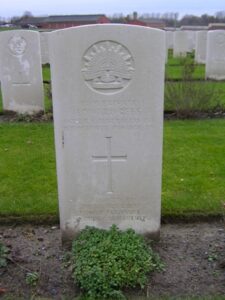
Joseph Thomas Rees, Private, 29634, South Wales Borderers. ‘Tommy’ was the son of George and Margaret Rees, of Cwm Backe, St. Clears, and the Husband of Annie Rees, of Rose Cottage, Pwll Trap. He enlisted at Carmarthen into the army, and was posted to France in January 1917, joining the 2nd Battalion, South Wales Borderers, which was attached to 87 Brigade, 29th Division. Joseph would have then fought at the Battle of Arras during April 1917, and during the Battle of Passchendaele later that year. Joseph was wounded by a bullet in the spine during the German Spring Offensive of April 1918, when the Division was in Flanders, and returned home for treatment. He died of wounds at King George’s Hospital, London, on 26 May 1918, aged 28 and was buried at Pwll Trap Congregational Chapelyard on 29 May. He left behind his bereaved wife and two small children.
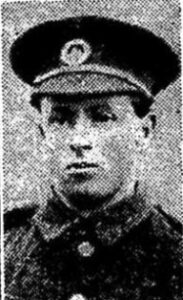
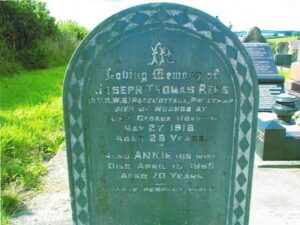
Thomas Reynolds, Private, 307482, Lancashire Fusiliers. Thomas was the son of Thomas and Anna Reynolds, of Craigwen Cottage, St. Clears. The family later resided at 66, Consort Street, Miskin, Mountain Ash, but kept up close ties with family back at St. Clears. Thomas had served with the 2/8th Battalion, Lancashire Fusiliers, which was attached to 197 Brigade, 66th (2nd East Lancs) Division. He had landed in France with the Division during March 1917, when it moved to the Flanders Coast. At the end of September 1917 they moved to Ypres, and took part in the Battle of Poelcapelle. They then moved south to the Somme, and on 21 March 1918 were hit by the German Spring Offensive at the Battle of St Quentin, and moving back west fought at the Actions at the Somme Crossings, and the Battle of Rosieres. Thomas became ill during this tumultuous period, and returned back to Britain where he was hospitalised at Northampton. He died on 3 May 1918, aged 20, and was brought home for burial at St. Clears (Trinity) Calvinistic Methodist Chapelyard. Thomas is not commemorated at St. Clears.
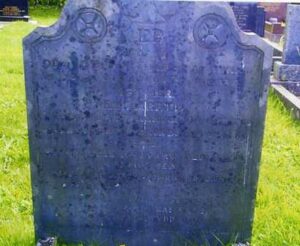
David Charles Saer, Lance Corporal, 320122, Welsh Regiment. David was born in Llanboidy, the son of Charles and Phoebe Saer. The family later moved to Capelmair Villa, St. Clears. ‘Dai’ worked on the local Postal Staff pre war, and had served in the Pembroke Imperial Yeomanry. He mobilised at Whitland at the outbreak of war. The Pembroke Yeomanry had formed in Tenby for Home Defence, as part of the South Wales Mounted Brigade, moving to the Norfolk coast. They arrived in Egypt in March 1916, and on 2 February 1917 were disbanded, joining with the Glamorgan Yeomanry to form the 24th Battalion, Welsh Regiment, as part of 231 Brigade, 74th (Yeomanry) Division. The Division first saw action during the Second Battle of Gaza. This is where David was killed in action, on 6 November 1917 aged 34. He is buried in Beersheba War Cemetery, Israel.
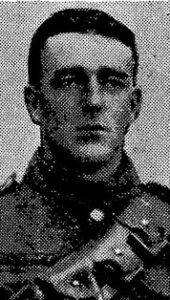
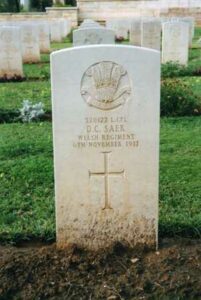
David Salmon, Private, 31204, Royal Welsh Fusiliers. David was the son of John and Sarah Salmon, of Lowlands, Narberth. His mother, Sarah, was from St. Clears, and the brother often visited family there. David enlisted at Carmarthen with his brother, originally into the Royal Field Artillery, with consecutive service numbers 98763 and 98764. Both brothers then transferred into the 1st Battalion, Royal Welsh Fusiliers, part of 22 Brigade, 7th Division. The Division had served on the Western Front since 7 August, 1914, and by early 1916 were stationed on the Somme. David was wounded by a German mortar shell on 6 February 1916, and died of wounds that same day, aged 21. He is buried at Point 110 New Military Cemetery, Fricourt. His brother Evan was wounded in the same explosion, and died the following day.
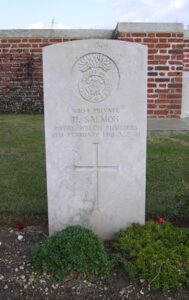
Evan Salmon, Private, 31203, Royal Welsh Fusiliers. Evan was the son of John and Sarah Salmon, of Lowlands, Narberth. His mother, Sarah, was from St. Clears, and the brother often visited family there. Evan enlisted at Carmarthen with his brother, originally into the Royal Field Artillery, with consecutive service numbers 98763 and 98764. Both brothers then transferred into the 1st Battalion, Royal Welsh Fusiliers, part of 22 Brigade, 7th Division. The Division had served on the Western Front since 7 August, 1914, and by early 1916 were stationed on the Somme. Evan was mortally wounded during the explosion of a trench mortar shell, and died just a day after his brother David (see above), on 7 February 1916, aged 23. He is buried at Corbie Communal Cemetery Extension.
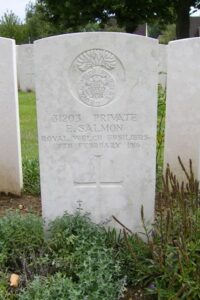
Brythonfyn Gwyn Thomas, Private, 1972, Royal Army Medical Corps. Gwyn was the son of John and Mary Jane Thomas, of The Blue Boar, St. Clears. He enlisted at Swansea into the 1/3rd Welsh Field Ambulance, Royal Army Medical Corps. The 1/3rd F.A. served with the 53rd (Welsh) Division, and landed with the Division at Suvla Bay on 9 August 1915. Gwyn was soon wounded, and died of wounds on a Hospital Ship off Gallipoli on 15 August 1915, aged 23. He is commemorated on the Helles Memorial, Gallipoli.
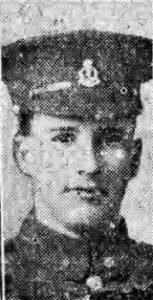
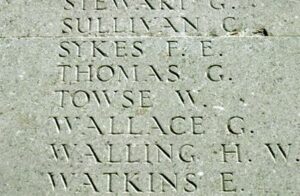
David Rees Thomas, Corporal, G/24803, Queen’s Own Royal West Kent Regiment. David was the son of Thomas and Esther Thomas, Pleasant View, St. Clears. David worked with the G.P.O. at Newcastle Emlyn prior to the outbreak of war, with his wife Mary A. Thomas, and their daughter Violet. He enlisted at Cardiff into the Welsh Horse Yeomanry, with the service number 829, and some time later he transferred into the 7th Battalion, Royal West Kent Regiment, which formed part of 55 Brigade, 18th (Eastern) Division. In December 1916 David arrived in France, so it is probable that he served in Gallipoli and Palestine with the Welsh Horse, before they were disbanded and merged with the Montgomery Yeomanry to become the 25th Battalion, Royal Welsh Fusiliers. Surplus men went to other regiments, and many transferred into the R.W.K.’s alongside David. David was killed in action while leading his platoon during a gallant charge on 12 October 1917. He was 25 years old, and is buried at La Laiterie Military Cemetery, Belgium.
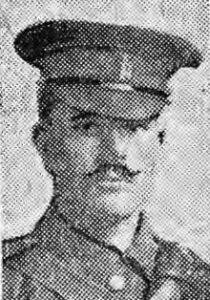
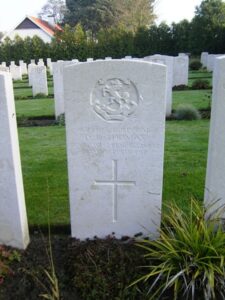
Harold Sylvanus Thomas, Private, 9909, Honorable Artillery Company. Harold was born at Aberystwyth, the son of John and Margaret Thomas, of Granville, 1, North Parade. He resided in St. Clears at the outbreak of war, where he worked as a Bank Clerk, and enlisted at Carmarthen on 8 December 1915, before entraining for Armoury House, London, after being posted to the 2nd Battalion, Honourable Artillery Company. The Battalion was attached to 22 Brigade, 7th Division, and on 3 October 1916 landed at Havre, taking part in the advance to the Hindenburg Line in early 1917 after the German withdrawal. In Spring 1917 the Battle of Arras was launched, and Harold was killed in action on 15 May 1917, during the Battle of Bullecourt, after being shot in the head. He was 25 years old, and is commemorated on the Arras Memorial, France.
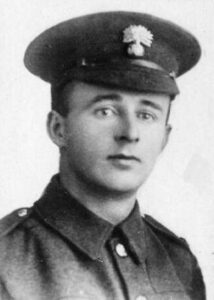
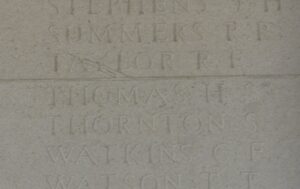
John Thomas, Corporal, S/4253, Rifle Brigade. John was the son of John and Eliza Thomas, of Penrhwl Cottage, Ffynongain, Llangynin. He enlisted at Pentre into the 13th Battalion, Rifle Brigade, which was attached to 111 Brigade, 37th Division. At the end of July 1915 the Division landed at Boulogne, and moved to the Tilques area, before taking up positions on the northern part of the Somme sector. John was mortally wounded during a spell in the trenches, and died as a result of his wounds on 18 November 1915, aged 29. John is buried at Humbercamps Communal Cemetery Extension, France.
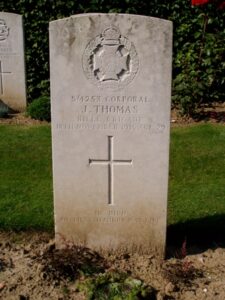
John Thomas, Private, G/20838, East Kent Regiment. John was born at Northampton, the son of David and Margaret Thomas. David and Margaret were originally from Whitland, and moved the family back to Llangynin prior to 1900. John enlisted at Carmarthen into the 1st Battalion, East Kent Regiment (The Buffs), part of 16 Brigade, 6th Division. The Division landed at St. Nazaire on 10 September 1914, and reinforced the BEF on the Aisne. They remained on the Western Front for the duration of the war, and were at Arras when the German Spring Offensive was launched on 21 March 1918. One of the first Divisions hit was the 6th Division, and John was Killed in Action on that first desperate day of the Battle. His body was lost on the battlefield, and so he is commemorated on the Arras Memorial, France. John does not appear to be commemorated locally.
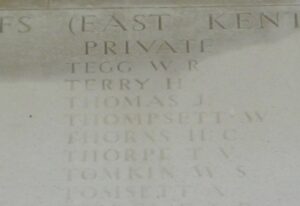
William John Thomas, Private, 65267, Welsh Regiment. William was the son of James and Martha Thomas, of Blewgyd, St. Clears. He was educated at Whitland Grammar School, and enlisted at Swansea into the army in May 1917. William made a short visit home on leave in February 1918 before joining the 9th Battalion, Welsh Regiment, which was attached to 58 Brigade, 19th (Western) Division. The division had been in France since July 1915, and had seen heavy fighting at Loos that year. In 1916 it had made a name for itself during the Somme offensive, before moving to Ypres early in 1917, and had fought with distinction at Messines Ridge and Passchendaele. William was killed in action during the early stages of the Spring Offensive, at the Battle of Kemmel, on 29 April 1918, aged 19. He is commemorated on the Tyne Cot Memorial, Belgium.
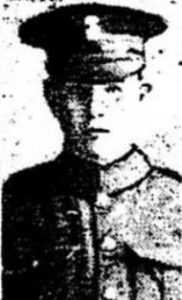
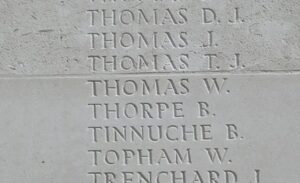
William Tucker, Private, 13208, Royal Welsh Fusiliers. William was born at Bancyfelin, the son of William and Anne Tucker. He worked as a Collier at Betws prior to the war and enlisted at Ammanford into the 9th Battalion, Royal Welsh Fusiliers, which was attached to 58 Brigade, 19th (Western) Division. The division landed at Havre in July 1915, and moved to positions near Givenchy. William fought through the Battle of Loos, and moved to the Somme with the division the following year. He survived the divisions famous attack on 1 July 1916 on Ovillers-La Boiselle, but was killed later in the battle while the battalion was in the line between Hessian and Regina Trench on 11 November 1916, aged 30. He is commemorated on the Thiepval Memorial, France.
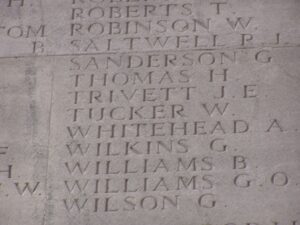
Rupert Washer, Acting Corporal, 201158, Welsh Regiment. Rupert was born at St Clears in 1884, the son of Henry Washer and Anna Washer (née John). The family moved to 9, Biddulph Street, New Dock, Llanelli by 1891, and Rupert married Mary Hannah Rogers in 1910. He enlisted at Llanelli into the 1/4th Battalion, Welsh Regiment, which was the local Territorial Battalion, attached to 159 Brigade, 53rd (Welsh) Division. The Division landed at Cape Helles, Gallipoli, on 9 August 1915, and was immediately thrown into action, spending the next few days in isolated pockets, fighting against a Turkish counter-attack during the Battle of Sari Bair. The Division remained here throughout the coming months, and suffered severe losses in manpower strength during the great November 1915 blizzard on Gallipoli, when its total strength was reduced to less than that of a full-strength Brigade. On 11 December 1915 the Division was evacuated to Mudros, and by 23 December 1915 were moved to Egypt. They remained on the Suez Canal Defences for the next twelve months, where it took part in operations against the Sultan of Darfur, and in March 1917 took part in the advance into Palestine. Rupert was killed during the First Battle of Gaza, on 26 March 1917, aged 32, and is commemorated on the Jerusalem Memorial, Israel. Rupert is not commemorated at St. Clears.
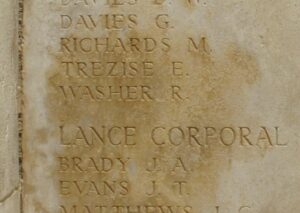
Ernest White, Private, 201232, Welsh Regiment. Ernest was born at Sheffield in 1893, and was a Tailor. He resided with the Howell family at Mile End, St. Clears prior to the outbreak of war, and enlisted at Carmarthen into the 1/4th Battalion, the Welsh Regiment, attached to 159 Brigade, 53rd (Welsh) Division. On 19 July, 1915 the Division embarked at Avonmouth for the Med, and landed at Suvla Bay on 9 August, fighting on the Peninsula until evacuation in December that year. The Division then moved to Egypt, before fighting in the Palestinian theatre, where they captured Jerusalem, and fought at Gaza. Ernest was killed in action while the 4th Welsh were advancing over a position known as Forfar Hill on 13 July 1918, aged 25. He is buried at Jerusalem War Cemetery, Israel.
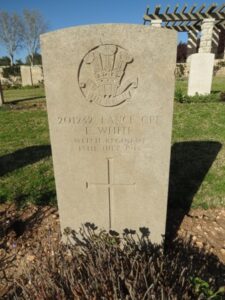
Gwyn Williams, Private, 21110, Royal Dublin Fusiliers. Gwyn was born at St. Clears, and had been brought up by James and Mary John, at Tynewydd, St. Clears. He had lived at Templeton prior to the war and married Jessie Miriam Scourfield of Templeton in 1915. He enlisted at Cardiff into the Army, and was posted to the 2nd Battalion, Royal Dublin Fusiliers, which was attached to 48 Brigade, 16th (Irish) Division. During December, 1915 the Division moved to France and concentrated in the Bethune area. They saw their first major action during the Somme Offensive, at the Battle of Guillemont, and also fought at the Battle of Ginchy. By May, 1917 the Division had moved to positions south of Ypres, where they fought at the Battle of Messines, and then moved north, fighting at the Battle of Langemarck, before returning to Arras. Gwyn was killed in action at Arras on 7 October 1917. He has no known grave, and is commemorated on the Arras Memorial, France, on Bay 9.
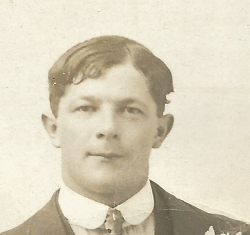
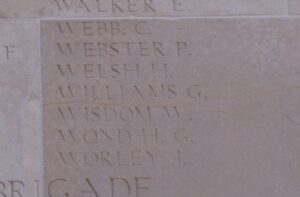
Howell Williams, Private, 5256, Welsh Regiment. Howell was born on 22 October 1892, the son of Joseph and Elizabeth Williams, of Arfryn, Hillside, St. Clears. He enlisted at Carmarthen into the 1/4th Battalion, Welsh Regiment, which was attached to 159 Brigade, 53rd (Welsh) Division. On 19 July 1915 the Division embarked at Avonmouth for the Med, and landed at Suvla Bay on 9 August. Howell was killed in action on the following day, during the terrible fighting of 10 August 1915, at the Battle of Sari Bair. He was 23 years old and is commemorated on the Helles Memorial, Gallipoli.
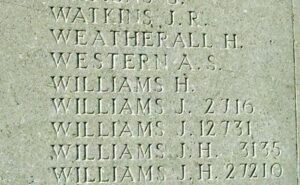
Thomas Williams, Private, 39646, South Wales Borderers. Thomas was born at St. Clears in 1892, the son of James and Elizabeth Williams. The family later moved to 8, Pontypridd Road, Porth. Thomas enlisted at Cardiff into the army and was posted to France, joining the 2nd Battalion, South Wales Borderers, which was attached to 87 Brigade, 29th Division. The battalion had fought at China and Gallipoli before sailing for France on 15 March 1916, and took up positions near Beaumont Hamel, on the Somme. The division took part in the Battle of Albert, which began on 1 July 1916. Thomas was wounded on the Somme, and brought back to the Casualty Clearing Station at Heilly in the Somme Valley. He died of wounds on 25 October 1916, aged 24 and is buried at Heilly Station Cemetery, Mericourt-L’Abbe. Thomas is not commemorated at St. Clears.
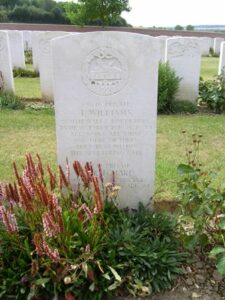
———————————————————————————————————————————————————–
World War Two, 1939-1945
Tadeusz Blach, Pilot Officer, P76698, Royal Air Force. Tadeusz was born in Warsaw, Poland on 20 October 1915. He was one of hundreds of Polish airmen who fled to Britain after the German invasion of Poland in 1939, and was posted to Blackpool at the Polish Air Force Base Depot and Training Centre. In December 1940 he joined 504 Squadron, Royal Air Force then transferred to 308 “City of Krakow” Squadron at RAF Northolt, taking part in sorties over France in his Spitfire MkIIB. On 9 August 1941 Tadeusz took off from Northolt on a training flight in Spitfire IIB P8676. While practising dogfighting, his Spitfire stalled and crashed near Ruislip, killing Tadeusz on impact. Taduesz had friends at St. Clears, so was buried at St. Mary’s Churchyard, St. Clears, on 15 August 1941 with full military honours. The Carmarthen Journal reported that mass was held in Carmarthen. The chief mourners included Mrs Cora Knight, Miss Lillian Atchinson, and Pilot Officer Dazusta, who was shot down over France and taken prisoner the following month. Tadeusz is not commemorated at St. Clears.
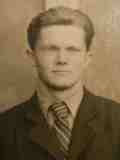
Gerwyn Bowen, Private, 3963440, Hampshire Regiment. Gerwyn was the son of William John Bowen and Annie Bowen (née Cunnick) of St. Clears. He served in the 1st Battalion, Hampshire Regiment, who landed on Gold Beach, on D-Day, 6th June, 1944. The Hampshires were part of the 231st Brigade, 50th (Northumbrian) Division, the objectives of the which were to cut the Caen-Bayeux highway, take the small port of Arromanches, link up with the Americans from Omaha Beach to the west at Port-en-Bessin, and link up with the Canadians from Juno Beach to the east. The 50th Division was also to take the Longues battery from the rear. Gerwyn was Killed in Action just over four weeks into the Battle of Normandy on 11 July, 1944, aged just 22, and is commemorated on the Bayeux Memorial, France.
Ellis Lyn Howells, Corporal, 4198127, Parachute Regiment. Ellis was the son of John Howell Howells and Mary Margretta Howells, of St. Clears. Prior to the outbreak of war, he worked in the G.W.R. Office at Carmarthen. He enlisted into the 10th Battalion, Royal Welch Fusiliers, but had volunteered, and was accepted, into the 6th Battalion, Parachute Regiment. Ellis was accidentally shot, and died on the way to Hospital on 11 May, 1943, aged 25, in North Africa, and is buried at La Petit Lac Cemetery, Tunisia.
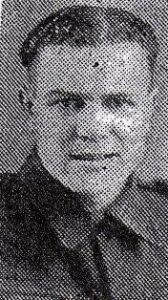
John Lloyd James, Sergeant, 3963431, Royal Armoured Corps. John was the son of John and Winifred Mary James, of St. Clears, and the husband of Dilys James, of 7, Corvus Terrace, St. Clears. He enlisted prior to the outbreak of war into the 4th Battalion, the Welsh Regiment (the Carmarthenshire Territorials), and upon the outbreak of war, was transferred into the 2nd Battalion, Derbyshire Yeomanry, part of the Royal Armoured Corps. John served in North Africa with the Yeomanry, before their recall to England to train for the invasion of Europe. The Derbyshire Yeomanry landed in Normandy during D-Day, 6 June, 1944. It was, uniquely for a Yeomanry regiment, serving as a divisional Reconnaissance Regiment, attached to 51st (Highland) Division, a task normally undertaken by the regiments of the Reconnaissance Corps. After landing in Normandy, 51st (Highland) Division was moved across Pegasus Bridge to the east bank of the River Orne. There it was to strengthen the bridgehead of the 6th Airborne Division, which had been under extreme pressure since D-Day from 21 Panzer-Division and the freshly-arrived 346 Infanterie-Division. After a disastrous first battle at Breville on 10 June, the division was moved in on the southern flank of the bridgehead and into the already-notorious ‘Escoville Triangle’. ‘The 2nd Derbyshire Yeomanry had a frustrating time, like all the Recce regiments in the British Army, in the bridgehead. Unlike the desert, there was no space to lead, roam, harass and destroy. 2 DY guarded bridges but took part in the bitter fighting for the villages of Escoville and Herouvillette, being employed mainly in an infantry role. In four days, casualties were almost 50, including the CO, Lt Col RH Palmer, but three MCs and four MMs were awarded. John was one of the fifty men of the unit to be killed during this period. He was killed in action on 16 June 1944, aged 29, and is buried at Ranville War Cemetery.
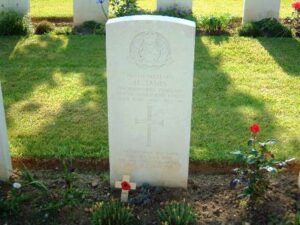
Clifford Jenkins, Private, 3914425, Monmouthshire Regiment. Clifford was the son of William and Margaret Annie Jenkins, and the husband of Dinah Olwen Jenkins, of St. Clears. He served in the 3rd Battalion, Monmouth Regiment, which had been part of 159 Brigade, 53rd (Welsh) Division during the early part of the war, based firstly in Ireland and then in England on home service. The battalion then became posted to 11th Armoured Division who had landed in Normandy as part of the reinforcing troops on 13 June 1944. The Division then took part in the drive out of the Normandy Beachhead, taking part in Operation Epsom, and Operation Goodwood. Clifford was Killed in Action during the ensuing Operation Bluecoat, on 14 August, 1944. He was aged 32, and is buried at St. Charles De Percy War Cemetery.
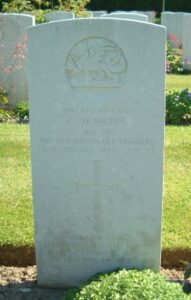
Claude Bowen Jones, Lieutenant, 119912, Royal Army Medical Corps. Claude was born at St. Clears, the son of William Bowen Jones and Edith Emily Jones (née Andrews), of St. Clears. He served in the Royal Army Medical Corps with the British Expeditionary Force in France at the outbreak of war. Claude was killed during the withdrawal to Dunkirk on 21 May 1940, aged 25. He is buried at Longuenesse (St. Omer) Souvenir Cemetery. Claude is not commemorated on the St. Clears memorial.
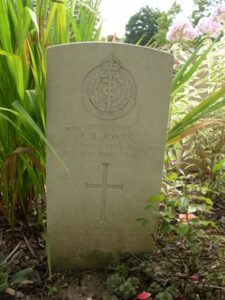
Wilfred Austen Lewis, Sergeant, 974474, Royal Air Force Volunteer Reserve. Wilfred was the son of David and Charlotte Lewis of Lewis Terrace, St. Clears. He married Dorothea Maud Harris at Llanelli in 1941. Wilfred worked prior to the war as a Reporter on the ‘Welshman’ Newspaper, and was well known locally. He served as a Flight Sergeant in 172 Squadron, RAFVR, who were based at Skitten flying the Vickers Wellington medium bomber. Wilfred was killed when his Wellington was lost on a patrol over the Bay of Biscay on 2 April 1943. He was 28 years old, and is commemorated on the Runnymede Memorial, Surrey. He left behind his wife and a baby boy.
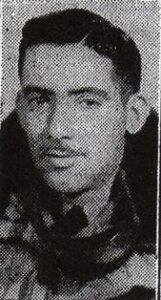
William John Lloyd, Able Seaman, C/JX 198531, Royal Navy. William was born at St. Clears on 15 February 1917, the son of Richard James Lloyd and Elisabeth Lloyd (nee Griffiths). The family came to live at 52, Garden Suburbs, Trimsaran at some time afterwards. William married Iris Gwyneth Evans, of Tumble, in 1939. He worked as a contractor’s labourer prior to enlisting into the Royal Navy and after completing his training was posted aboard the WW1 era Ceres group c-class light cruiser, HMS Curacoa. The ship had been in reserve and was then used as a training ship prior to being refitted and converted into an anti-aircraft cruiser just after the outbreak of war. In January 1940 the ship was assigned to the Home Fleet, then took part in the ill-fated Norwegian Campaign, escorting a British troop convoy to Åndalsnes and then landed a battalion of the Sherwood Foresters at Molde. She returned to Britain, but was ordered back to Åndalsnes to protect the beachhead from German aircraft, and was damaged by a German bomb soon afterwards, which forced her to return home for repairs. Curacoa was then assigned to the Western Approaches and began convoy escort duties. On the morning of 2 October 1942, Curacoa rendezvoused north of Ireland with the ocean liner Queen Mary, which was packed with 10,000 American Troops. Queen Mary was following the standard pattern of zig-zagging, to help prevent against torpedo strikes, when Curacao cut across her bow. Queen Mary struck the destroyer amidships, sending her to the bottom in six minutes, with the loss of over 200 men. William was 25 years old when he died that day, on 2 October 1942, and is commemorated on the Chatham Naval Memorial, Kent. William is not commemorated at St. Clears, but on the Trimsaran War Memorial.
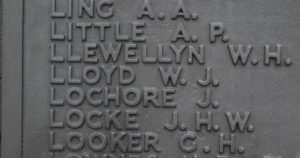
Gwyn Morris, Aircraftman, 639045, Royal Air Force Volunteer Reserve. Gwyn was the son of William and Rachel Morris of St. Clears. He served as Aircraftman 2nd Class in 210 Squadron, RAFVR, who were based at Oban flying the Short Sunderland ‘Flying Boat’. On 15 March 1941, Gwyn was flying aboard the Short Sunderland I, Serial P9624 on a convoy escort mission. The aircraft was recalled to Oban, and crashed during landing, killing five of the crew, including Gwyn. He has no known grave, and is commemorated on the Runnymede Memorial, Surrey.
Joseph John Hamlyn Phillips, Private, 14572494, The Border Regiment. Hamlyn was the son of Benjamin and Nano Phillips, of Bancyfelin, and the husband of Esther Phillips, of Aberdare. He served with the 2nd Battalion, Border Regiment, which was based in the Far East. The battalion fought behind Japanese lines in Burma for much of the war, before flying out of Myitkyina on 26 July 1944 for a well deserved rest. Hamlyn died in India on 7 August 1944, aged 34, and is buried at Imphal War Cemetery, India.
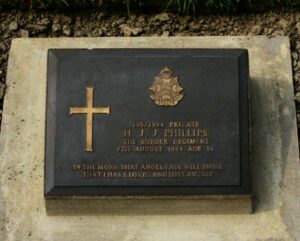
Eric Victor Seymour, Sergeant (Observer), 526601, Royal Air Force. Eric was born in Pendine, the son of Richard William and Emily Seymour. The family later moved to St. Clears, residing in Holborn House. He enlisted into the Royal Air Force in 1936, and trained as an Observer. Eric flew with 7 Squadron, RAF, based at Oakington in Cambridgeshire. Between the wars No.7 squadron was equipped with various aircraft including the Handley Page Heyfords, Vickers Wellesleys and Armstrong Whitworth Whitleys and became the leading bomber squadron, winning the Laurence Minot Memorial Bombing Trophy more than any other squadron. At the outbreak of World War II, the squadron was equipped with Handley Page Hampdens, until August 1940, when it equipped with the RAF’s first four engined bomber, the Short Stirling Mk I – becoming the first RAF squadron to be equipped with four engined bombers. The first raid by No.7 was on 10 February 1941 on Rotterdam. The squadron later settled down to a night bombing role, before becoming part of the elite Pathfinder Squadron. On the night of 23 March, 1941, the Squadron were assigned a bombing mission on Calais. Eric formed part of the crew of the Short Stirling Mk I, serial number N3643/Op, piloted by Squadron Leader Stuart Robertson. The mission was carried out successfully, but on the return journey, the Stirling caught fire. The pilot managed to get the Stirling back over the channel, and attempted a forced landing at RAF Hazelwood Common, Cambridgeshire, but the aeroplane struck power cables, before hitting the roof of a house, and crashed at 01.52, on 24 March. All but one of the crew was killed in action in the crash. Squadron Leader Robertson was buried at Long Stanton Churchyard, alongside Sergeant Philip Green and Sergeant Gilbert Short. Sergeant Anthony Roberts was buried at Derby Cemetery, Sergeant John Clarke was buried in Marton Churchyard, Lancs, and 23 year old Eric was buried at Southend on Sea Cemetery. The lone survivor, Sergeant F. B. White was injured. Eric’s parents were informed of Eric’s tragic death by his Station Commander, who wrote, ‘He came to us with vast operational experience, and his services will be greatly missed, not only to his own Squadron, but to the RAF, which he dearly loved.’ Eric is not commemorated locally.
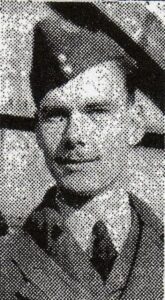
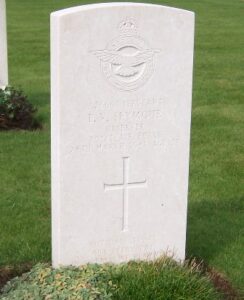
Hendrick Desmond Hamilton Williams, Civilian Air Raid Victim. Hendrick was the son of Thomas David Williams and Anna Williams, of Penlan, Salem, St. Clears. He owned and ran the Swan Hotel in St. Clears, and was visiting family at 8, Gwyther Street, Pembroke Dock when the Town was hit by a massive German Air Raid on the morning of 12 May, 1941. Hendrick was killed when the house was hit by a bomb. He was 42 years old, and as far as is known, is not remembered by any memorial in St. Clears.